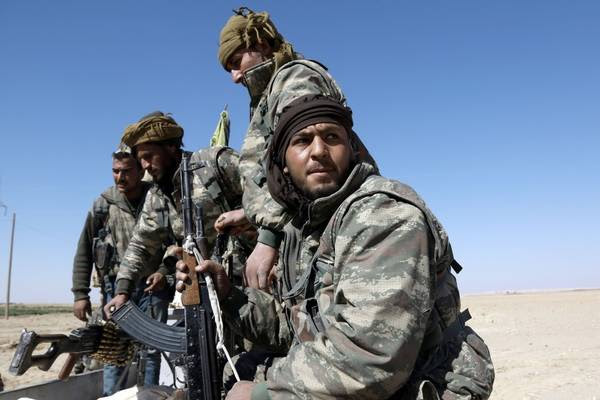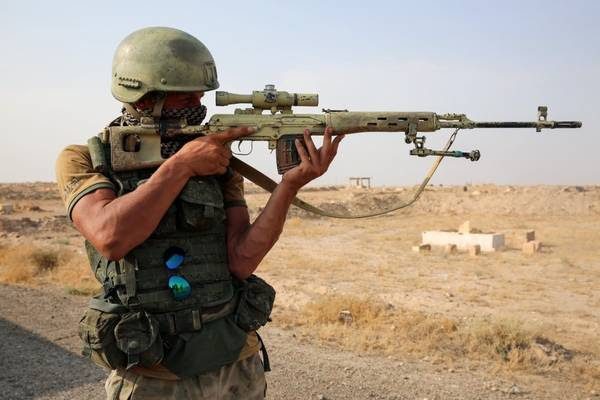How far could the dangerous endgame in eastern Syria go?

The war against the Islamic State always promised to get messy in its final stages, as the militants retreat and rival forces converge from different directions. That moment has arrived.
World powers and their local allies are scrambling to control the remote desert province of Deir al-Zour in eastern Syria, in an accelerating racethat is being compared to the fall of Berlin in 1945.
Under Islamic State control since 2014, the province is three times the size of Lebanon and consists mostly of empty desert. It also happens to contain most of Syria’s oil resources. But much more is at stake: the future contours of postwar Syria; Kurdish aspirations to some form of autonomy; and the competition for influence in the Middle East among the United States, Iran and Russia.

Fighters from the U.S.-allied Syrian Democratic Forces on the northern outskirts of Deir al-Zour on Feb. 21. (Delil Souleiman/Agence France-Presse via Getty Images)
On the ground the combatants fall into two camps: one backed by Russia and Iran, the other by the United States and its allies.
Advancing from the north are the U.S. backed Syrian Democratic Forces, or SDF, a Kurdish-led coalition of Kurdish and Arab forces that is expanding the boundaries of the autonomous area they have carved out farther north. They are accompanied by American Special Operations troops and backed by U.S. airstrikes.
Making rapid progress from the east are the Syrian government and its allies, accompanied by Russian and Iranian advisers and backed by Russian airstrikes. They're fulfilling President Bashar al-Assad’s goal of reasserting Syrian sovereignty over every inch of Syria — and also making sure the United States stays out.
The two forces came within three miles of one another last week in the city of Deir al-Zour, the provincial capital. After Syrian troops drove the Islamic State out of most of the southern portion of the city, the SDF made a dash south through the desert and is positioned at the city’s northern edge.
The potential for deadly miscalculation has been made clear: As The Washington Post’s Louisa Loveluck reported, Russian warplanes allegedly bombed an SDF position on Saturday and wounded one of the group's fighters. Russia has denied the strike, and the United States says it is investigating what appeared to be the first Russian challenge to its presence in the province.
But the city of Deir al-Zour is not the real focus of the race. A far bigger prize lies farther south, in the towns strung out along the Euphrates Valley. They include Mayadin, where it is thought that many senior Islamic State leaders have relocated, and Bukamal, which controls the main border crossing to Iraq. Those towns, according to Col. Ryan Dillon, the U.S. military spokesman in Baghdad, are the next objectives for the U.S.-led coalition.

Dillon denied there is any kind of “race” underway with the Syrian army and its allies. “We’re there just to defeat ISIS and to set the conditions for follow-on stability in the region,” he said, using another name for the Islamic State.
But Syria and its allies also are aiming to take these towns, which control access to the Iraqi border and would enable Iran to reopen the Tehran-Baghdad-Damascus land route it maintained before the Syrian war.
Syria and Iran have made no secret of their intent to stop the United States and its allies from taking the area. One of Assad’s closest advisers, Bouthaina Shaaban, told Hezbollah’s Al-Manar TV station on Friday that it was Syria’s “strategic intent” to block the United States and its allies, equating their presence to that of the Islamic State.
“Whether it’s the Syrian Democratic Forces or [the Islamic State] or any illegitimate foreign force in the country ... we will fight and work against them so our land is freed completely from any aggressor,” she added, according to comments quoted by Iran’s Press TV.
Experts also aren't buying American denials of a race for territory. Nicholas Heras of the Center for a New American Security thinks it is a race the United States probably will win. Syrian government forces lack the capacity to retake large areas from the Islamic State, he said, and may struggle to make gains.
“Assad is playing a game of chicken with a superpower. Even with Russia’s backing, his forces’ position is still just now being reestablished in eastern Syria,” he said. “If Assad pushes the U.S. military, it can push back, and much harder.”
But Aron Lund, a Syria analyst who writes for the Century Foundation, questioned whether the United States has the appetite for a war with the Assad regime, Iran and Russia that could perhaps spill across the region. Much will depend on whether the Trump administration’s pledges to roll back Iranian influence in the region extend that far, he said.
Until now, encounters between the two sides — including one near Raqqa and another at the U.S. outpost at Tanf on the Syrian-Iraqi border — have been settled through deconfliction agreements that draw lines delineating where rival armies may operate. “They do seem to get pretty far with these talks,” Lund said.

A Russian soldier looking through the scope of a sniper rifle during a Russian Defense Ministry media tour on the outskirts of Deir al-Zour on Sept. 17. (Dominique Derda/Agence France-Presse via Getty Images)
But those agreements are ad hoc affairs, crafted only after an area has been seized and a clash seems imminent, giving both sides an incentive to snatch territory. And with the Islamic State so far putting up little resistance in the province, there is a risk that events on the ground will outpace the drawing of lines.
All eyes now are on the Euphrates River, which serves as an informal demarcation line. Both sides will have to cross the river, in opposite directions, if they are to fulfill their goals — and both say they are planning to do so. Unverified photographs posted on social media last week purportedly showed Russian pontoon bridges being positioned in preparation for Syrian troops to cross over.
Once the river is breached, the race will be on in earnest for control of the eastern Syrian desert. Whether that race will prompt a wider war is still an open question.

No comments:
Post a Comment